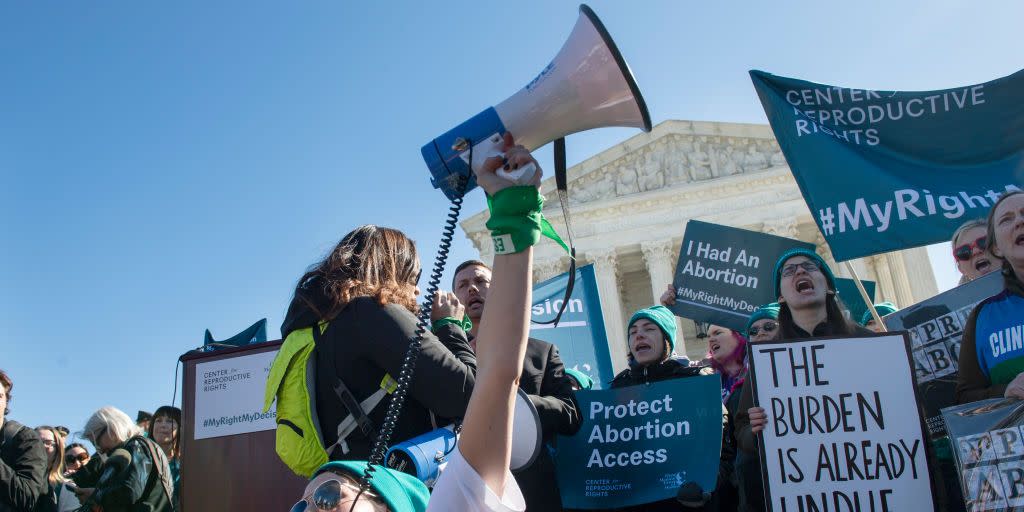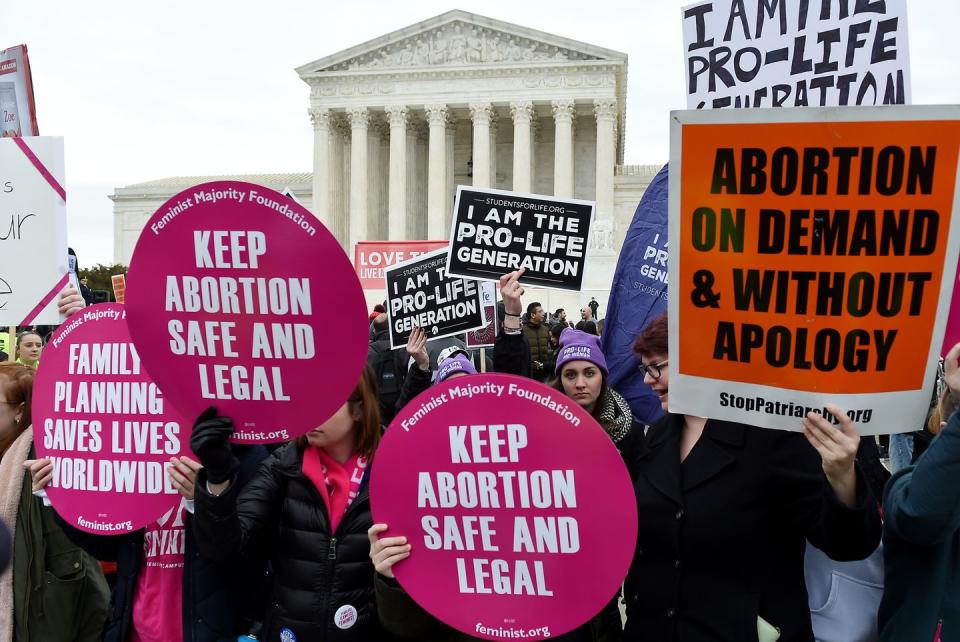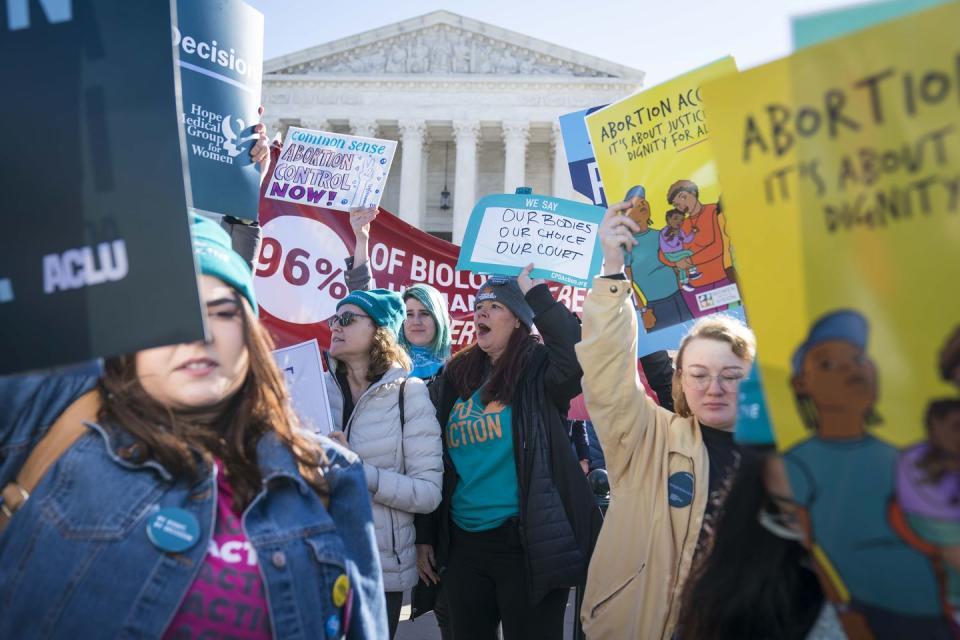Inside the Supreme Court for the Biggest Abortion Fight of the New Decade

By the time the justices took their seats on Wednesday morning, the cavernous marble hall of the Supreme Court of the United States was jammed. From the packed press section, Justice Ruth Bader Ginsburg was nothing but a sliver of forehead and slicked-back grey hair hovering over the varnish of the long wooden bench. But you couldn’t miss Justice Brett Kavanaugh, the newest member of the court, sitting tall in his black leather seat at the far end. He was the real reason we were there, waiting to hear arguments in June Medical Services v. Russo, a high-stakes Louisiana case with the potential to reshape abortion rights across America.
If abortion feels like it should’ve been a settled legal issue decades ago, the case at hand feels especially like déjà vu—the court decided a nearly identical case just four years ago, striking down a restrictive Texas abortion law like the one Louisiana is currently defending. In that 2016 case, the court found the Texas law, which shuttered half of the state’s clinics by requiring abortion providers to have admitting privileges at hospitals, unconstitutional.
But the court that decided that case no longer sits on the bench. In place of Justice Anthony Kennedy, a broadly conservative justice who voted to strike down the Texas law and retired in 2018, we have Kavanaugh—a conservative widely viewed as hostile to abortion rights.
June Medical Services v. Russo is the first abortion lawsuit to be heard by this new court transformed by President Donald Trump, and its outcome could carry serious implications for the future of Roe.
The case pits Louisiana against one of the state’s last three abortion clinics, Hope Medical Group for Women in Shreveport, and two of its last five abortion doctors. The law—which only took effect briefly before it was blocked by a federal judge—would force doctors to obtain admitting privileges at hospitals within 30 miles of the clinics where they work. The district court found that the state’s four doctors without privileges applied to 15 hospitals over one and half years and were rejected by them all. (Hospitals can reject doctors for a variety of reasons unrelated to competency.) If the law is upheld, Louisiana would be left with one provider for a state where roughly 8,000 abortions were performed in 2018.
But its repercussions could ripple across the country. Abortion rights advocates say it would mean open season for anti-abortion states to pass similarly restrictive laws that gut access. And it would signal a new court keen to revisit past abortion precedents—the most likely way the anti-abortion movement will succeed in overturning Roe.
At base, the case hinges on a simple question: Can what’s unconstitutional in Texas be constitutional just four years later in Louisiana?
“This case is about respect for the Court's precedent,” began Julie Rikelman, counsel for the clinic and a lawyer with the legal non-profit the Center for Reproductive Rights. “There really is no way to apply Whole Woman's Health and uphold this law, there just isn't,” Rikelman had said in a call with reporters a few weeks before the arguments.
Before the court, she argued that a second question posed in the case presents an even more profound challenge to decades of abortion precedents: whether abortion providers have the right to sue on behalf of their patients.

The state argues that providers don’t have close enough relationships with their patients to sue on their behalf through what’s called third-party standing, a claim Justice Samuel Alito seemed to support.
“That’s amazing!” Alito responded more than once to Rikelman’s repeated assurance that abortion doctors have standing in the case regardless of any alleged conflict of interest. (Louisiana has argued abortion doctors, by virtue of challenging a law the state claims will protect women’s health, are at odds with their patient’s well being). Later, Justice Stephen Breyer would note that at least eight previous Supreme Court precedents established third-party standing for abortion providers. He’d even suggested that if the Court were to undo these precedents, why not go all the way back and overturn rulings from centuries ago?
“I don’t want to go back to 1789,” Jeffrey Wall, another lawyer arguing Louisiana’s case, responded.
“You want to go back for 40 years?” Breyer countered—a reference to Roe v. Wade. Wall answered that previous abortion precedents hadn’t taken up the question of doctor-patient conflicts of interest.
The issue could wreak havoc on reproductive rights jurisprudence, knee-capping the vast majority of abortion rights cases, which are brought by clinics and doctors. (The Center for Reproductive Rights alone has 31 ongoing cases in 17 states.)
But it didn’t steal all the oxygen, and none of the other conservative justices jumped on that line of questioning. (Justice Neil Gorsuch and Justice Clarence Thomas asked no questions at all.)
Instead, the bulk of the debate hinged on two points: Were Louisiana’s doctors truly unable to obtain admitting privileges, or did they “sabotage their applications,” as the lawyer for the state, Solicitor General Liz Murrill, argued. And was the court’s previous ruling that admitting privileges provide no medical benefit in Texas somehow limited to Texas, or could it apply to all such laws in every state?
The court’s liberal justices interrogated Murrill over her arguments that abortion providers didn’t make the effort to gain admitting privileges and the need for the rule at all, given that abortions are exceedingly safe procedures.
At one point, Justice Elena Kagan noted that Whole Woman’s Health found that “a state can't say it's doing this for credentialing purposes if the hospital's reasons for denying admitting privileges have nothing to do with the doctor's quality.” Like Texas, Louisiana's record showed “admissions privileges rest on many things. It could rest on qualifications, but it could rest on the number of patients a doctor has. It could rest on whether a particular hospital needs more providers. It could rest, too, on a general view that they don't want abortion providers in that hospital.”
“Is it right that there is evidence in the record that Hope Clinic has served over 3,000 women annually for 23 years, so that's around 70,000 women, and has transferred only four patients ever to a hospital?” Justice Kagan then asked Murrill.
“It’s four that they know of,” Murrill countered.
Justice Ginsburg repeatedly questioned the logic of a 30-mile limit for admitting privileges, given that most abortion complications occur when women have gone home—especially for medication abortions—that could put them hundreds of miles away from the clinic.
It’s not clear what Chief Justice John Roberts, a conservative with a long record of voting to uphold anti-abortion laws, made of the case, though he suggested at one point there is no state where admitting privileges for abortion doctors could offer any health benefits. But his role will be pivotal—Roberts voted with the Court’s four liberal justices to bar Louisiana’s law from taking effect last year after it was upheld by Fifth Circuit Court of Appeals, and he’s viewed as the key vote that will decide this case, which will likely fall along ideological lines.
Outside the Court, anti-abortion and reproductive rights groups had been rallying since 8 a.m, with the latter group dwarfing the former by nearly two to one. Their chants blended together under a cloudless blue sky at the foot of the court’s towering stone pillars.
At the anti-abortion rally, speakers painted abortion providers as profit-hungry to the point of endangering women’s health. Katrina Jackson, the anti-abortion Louisiana Democrat who authored the law, told ELLE.com it had been an emotional day. “You literally, you just fall into prayer, and you hope and pray that they protect women,” she told me.

In a move that seemed destined to shift the news cycle away from the substance of the case, Sen. Chuck Schumer, the Democratic leader, sparked a political uproar and drew condemnation from the Chief Justice for attacking Kavanaugh and Gorsuch, Trump’s appointments to the bench, on the court’s steps.“You have released the whirlwind, and you will pay the price,” he said. “You will not know what hit you if you go forward with these awful decisions.”
Chief Justice Roberts called the comments “inappropriate” and “dangerous.” “All members of the court will continue to do their job, without fear or favor, from whatever quarter,” he said.
Optimism pervaded both sides after the arguments. Each praised their lawyers’ performance before the Court. Both sides hoped the justices would “do the right thing.” They each have a handful of anxious months ahead, waiting for a decision expected in June.
“It’s high time that we realize that rights given blindly can be easily taken away,” Lakeesha Harris, an activist for reproductive justice for women of color in Louisiana, told the rally of abortion-rights supporters. “We ask that everyone pay attention to what’s going on in Louisiana as not just something that’s happening down there. It is what’s happening in our nation.”
Kathaleen Pittman, the administrator of the Hope clinic in Shreveport, was moved by the crowd, she said.
“When we became part of this case six years ago, I never imagined we would be at the Supreme Court today,” she shouted to a sea of supporters. "I cannot tell you how moving it is to see all of you here, all of these faces rallying behind us, behind a small independent clinic in northwest Louisiana."
“Of course, this case is about more than Hope. This case is bigger than Louisiana. This case is about women across the country being able to access abortion in a real way, not just in theory,” she said. “We all know a right you cannot access is no right at all.”
You Might Also Like

